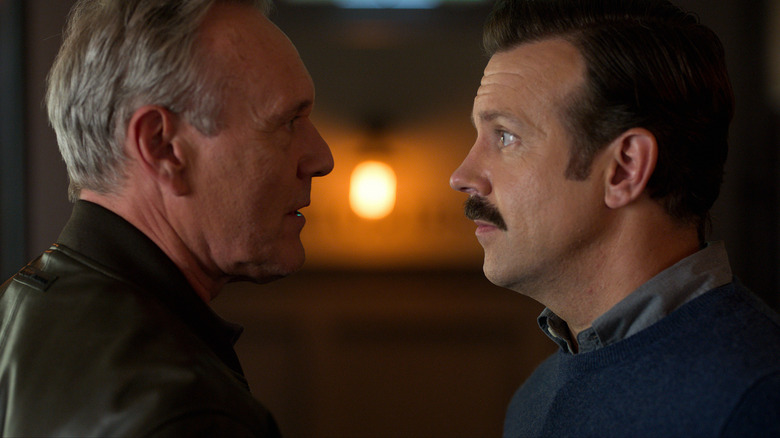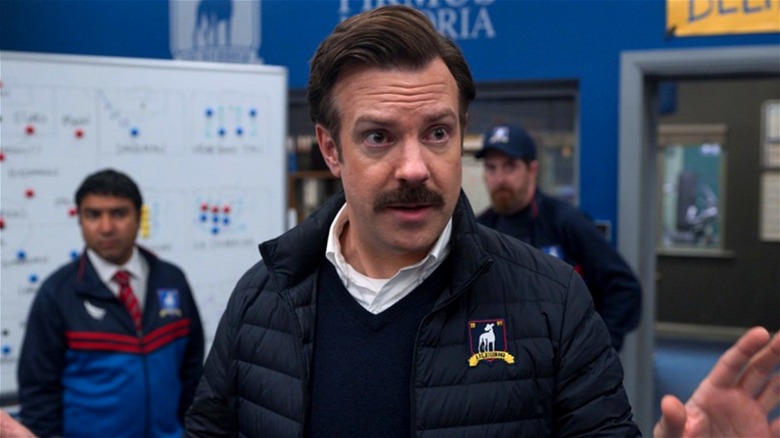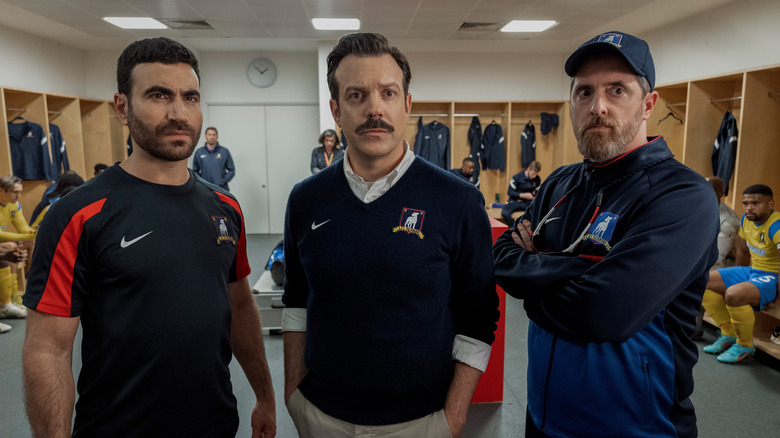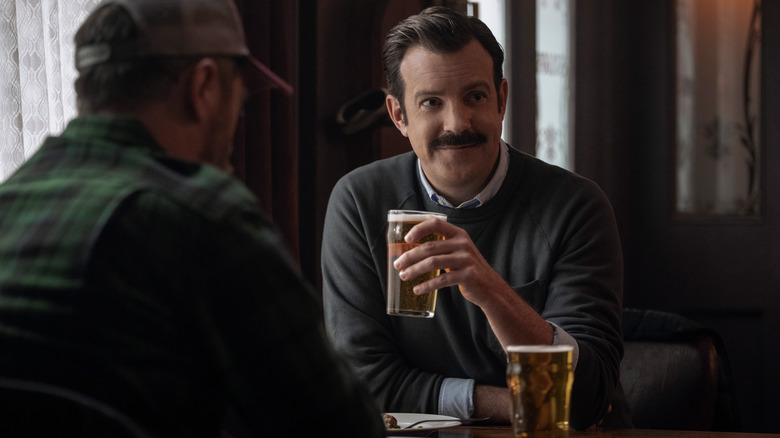Remember August 2020? The world was, to put it politely, in complete shambles. COVID-19 had been raging for months, and though a vaccine wasn’t that far away, there was still no sign of it yet for the general public. Death tolls were rising, everyone was stuck inside and isolated from friends and loved ones — and also, it was August, so depending on where you live, it was hot as hell. It was straight up not a good time. And then “Ted Lasso” came along.
A full series inexplicably based on a one-off character developed years beforehand by star and creator Jason Sudeikis, “Ted Lasso” premiered on Apple TV+ on August 14, 2020 … and even more inexplicably, it totally worked. As Ted, Sudeikis brought his inherent likability to a character who’s always ready to look on the positive side, and he was surrounded by a veritable murderer’s row of extraordinary actors with the capacity for both deep emotion and side-splitting comedic set pieces. Everyone from co-writers and creators Brendan Hunt and Roy Goldstein to future Emmy winner (and former “Shame Nun”) Hannah Waddingham, to immediate fan favorite Juno Temple, pulled their weight alongside Sudeikis. Before anyone knew it, “Ted Lasso” became one of the year’s most beloved shows.
And then the second and third seasons happened.
Now, in the aftermath of what was likely the series finale of “Ted Lasso,” it’s time to ask a tough question. Was “Ted Lasso” ever actually good, or were we totally fooled?
It would be foolish to pretend that there aren’t great moments in the first season of “Ted Lasso.” Ted finally winning over the revenge-driven Rebecca (Waddingham) with outright charm and homemade biscuits is adorable. The friendship that forms between Keeley (Temple) and Rebecca remains one of the show’s very best through-lines until the end, even when the show kind of forgets about it (but more on that in a bit). The moment where Ted confronts Rebecca’s objectively awful ex-husband — and former AFC Richmond owner — Rupert (Anthony Head) over a game of darts, only to beat him with both hands because the man wildly underestimated Ted, is a much-memed and honestly wonderful piece of character development.
These pieces might not make a whole, though. The timing of this game really can’t be overlooked, in that people around the world were positively desperate for human connection and kindness, both of which “Ted Lasso” offered in spades. The truth about the first season of “Ted Lasso” is that it would have made a pretty good and satisfying miniseries, when all is said and done. The biggest cracks in the show’s foundation were certainly present from the very beginning, but they might never have come to light if it had just quit while it was ahead.
After Season 1 revealed that the eternally cheerful Ted is prone to occasional panic attacks, Season 2 doubled down on the character’s mental health — and initially, this definitely did seem promising. A show developing an introspective attitude towards mental health is rarely a bad thing, especially if it brings awareness to the issue, and “Ted Lasso” brought on a great foil for Ted in Dr. Sharon (Sarah Niles), the one person who seems able to see through his relentless optimism.
Season 2 of “Ted Lasso” also opened with one of the players killing a dog — specifically, the team’s greyhound mascot — with a poorly-aimed kick, which feels cartoonish at best and actually gross at worst. After Apple ordered two extra episodes for the season that were reportedly a surprise for the creative team, two standalone episodes came along: “Carol of the Bells,” a Christmas episode that ended up airing in mid-August, and “Beard After Hours,” an episode centered around Brendan Hunt’s Coach Beard that was either viewed as amazing or completely awful. Thanks to these, the pacing of Season 2 ultimately feels a little off-kilter, and by its end, Dr. Sharon is set to leave the show (a major narrative loss), kit man turned “wonder kid” Nate (Nick Mohammed) has completed his villain arc, and it all still feels… fine. Not as good as Season 1, but pretty good! Don’t get too excited, though. Season 3 is on the horizon.
Without question, Season 3 of “Ted Lasso” is the show at its absolute worst. Yes, there’s still some funny jokes and asides, and yes, the cast is as winning as ever — but that doesn’t fix the issues at hand, of which there are several. Let’s start with the episode lengths, which are, frankly, egregiously long. A show that was once a breezy thirty or so minutes bloated itself to hour-long episodes, with the run times creeping higher and higher as the season continued. The finale, “So Long, Farewell,” is seventy-six minutes long.
Season 3 also did a few things that were just flat out frustrating. The writing, once quick and snappy, felt a lot clunkier (see: the locker room scene about photos and consent). First, it introduced plot threads here and there — Rebecca’s green matchbook, the super-powered soccer star Zava (Maximilian Osinski) joining the team for literally five minutes, Nate’s continued villain arc — only for them to mean nothing at all.
Nate’s villain arc was simply… undone with no fuss at all, like someone rebooted him. The show also made the frankly insane choice to physically separate most of the characters all of the time, despite the fact that the real joy of this show is its ensemble. Ted spent a lot of time alone, Rebecca and Keeley barely had any scenes together, and the camaraderie just felt… long gone. Most of Season 3 just didn’t feel like “Ted Lasso” at all, really.
Whether or not “Ted Lasso” as a whole is really over remains to be seen, but the character of Ted has officially returned to Kansas to be with his family. Sadly, this episode feels like a return to Season 1’s form, with a heartwarming ending for a character who did charm us back in 2020. But was this a finale like “The Office,” where a once-great show had a long stretch of misery followed by a pitch-perfect finale? Or was “Ted Lasso” not all that great to begin with?
It might be time to admit that “Ted Lasso” was a fine show with good jokes and an outstanding cast, and not the new standard-bearer for television comedies. The world needed warmth and kindness and connection in late 2020, and “Ted Lasso” gave that to us in spades during its first season. It was a warm embrace during a time when we weren’t supposed to actually embrace people because it wasn’t safe, and for that, the first season is still special. It feels, though, like we were fooled — like “Animal Crossing” and sourdough starters, maybe we can simply appreciate “Ted Lasso” as a relic of a hard time in human history rather than one of TV’s best comedies.
Also, if you want to watch a show that is the new standard-bearer for television comedies, “The Other Two” is over on Max.
×
Cookies help us deliver our Services. By using our Services, you agree to our use of cookies. Learn More.
Exclusives
Ted Lasso Series Finale: Was This Ever A Good Show, Or Were We Duped?
Apple TV+
By Nina Starner/May 31, 2023 1:54 pm EST
Remember August 2020? The world was, to put it politely, in complete shambles. COVID-19 had been raging for months, and though a vaccine wasn’t that far away, there was still no sign of it yet for the general public. Death tolls were rising, everyone was stuck inside and isolated from friends and loved ones — and also, it was August, so depending on where you live, it was hot as hell. It was straight up not a good time. And then “Ted Lasso” came along.
A full series inexplicably based on a one-off character developed years beforehand by star and creator Jason Sudeikis, “Ted Lasso” premiered on Apple TV+ on August 14, 2020 … and even more inexplicably, it totally worked. As Ted, Sudeikis brought his inherent likability to a character who’s always ready to look on the positive side, and he was surrounded by a veritable murderer’s row of extraordinary actors with the capacity for both deep emotion and side-splitting comedic set pieces. Everyone from co-writers and creators Brendan Hunt and Roy Goldstein to future Emmy winner (and former “Shame Nun”) Hannah Waddingham, to immediate fan favorite Juno Temple, pulled their weight alongside Sudeikis. Before anyone knew it, “Ted Lasso” became one of the year’s most beloved shows.
And then the second and third seasons happened.
Now, in the aftermath of what was likely the series finale of “Ted Lasso,” it’s time to ask a tough question. Was “Ted Lasso” ever actually good, or were we totally fooled?
Was Ted Lasso’s first season as amazing as we remember?

It would be foolish to pretend that there aren’t great moments in the first season of “Ted Lasso.” Ted finally winning over the revenge-driven Rebecca (Waddingham) with outright charm and homemade biscuits is adorable. The friendship that forms between Keeley (Temple) and Rebecca remains one of the show’s very best through-lines until the end, even when the show kind of forgets about it (but more on that in a bit). The moment where Ted confronts Rebecca’s objectively awful ex-husband — and former AFC Richmond owner — Rupert (Anthony Head) over a game of darts, only to beat him with both hands because the man wildly underestimated Ted, is a much-memed and honestly wonderful piece of character development.
These pieces might not make a whole, though. The timing of this game really can’t be overlooked, in that people around the world were positively desperate for human connection and kindness, both of which “Ted Lasso” offered in spades. The truth about the first season of “Ted Lasso” is that it would have made a pretty good and satisfying miniseries, when all is said and done. The biggest cracks in the show’s foundation were certainly present from the very beginning, but they might never have come to light if it had just quit while it was ahead.
Season 2 of Ted Lasso provided diminishing returns

After Season 1 revealed that the eternally cheerful Ted is prone to occasional panic attacks, Season 2 doubled down on the character’s mental health — and initially, this definitely did seem promising. A show developing an introspective attitude towards mental health is rarely a bad thing, especially if it brings awareness to the issue, and “Ted Lasso” brought on a great foil for Ted in Dr. Sharon (Sarah Niles), the one person who seems able to see through his relentless optimism.
Season 2 of “Ted Lasso” also opened with one of the players killing a dog — specifically, the team’s greyhound mascot — with a poorly-aimed kick, which feels cartoonish at best and actually gross at worst. After Apple ordered two extra episodes for the season that were reportedly a surprise for the creative team, two standalone episodes came along: “Carol of the Bells,” a Christmas episode that ended up airing in mid-August, and “Beard After Hours,” an episode centered around Brendan Hunt’s Coach Beard that was either viewed as amazing or completely awful. Thanks to these, the pacing of Season 2 ultimately feels a little off-kilter, and by its end, Dr. Sharon is set to leave the show (a major narrative loss), kit man turned “wonder kid” Nate (Nick Mohammed) has completed his villain arc, and it all still feels… fine. Not as good as Season 1, but pretty good! Don’t get too excited, though. Season 3 is on the horizon.
Season 3 was the worst outing yet for Ted Lasso

Without question, Season 3 of “Ted Lasso” is the show at its absolute worst. Yes, there’s still some funny jokes and asides, and yes, the cast is as winning as ever — but that doesn’t fix the issues at hand, of which there are several. Let’s start with the episode lengths, which are, frankly, egregiously long. A show that was once a breezy thirty or so minutes bloated itself to hour-long episodes, with the run times creeping higher and higher as the season continued. The finale, “So Long, Farewell,” is seventy-six minutes long.
Season 3 also did a few things that were just flat out frustrating. The writing, once quick and snappy, felt a lot clunkier (see: the locker room scene about photos and consent). First, it introduced plot threads here and there — Rebecca’s green matchbook, the super-powered soccer star Zava (Maximilian Osinski) joining the team for literally five minutes, Nate’s continued villain arc — only for them to mean nothing at all.
Nate’s villain arc was simply… undone with no fuss at all, like someone rebooted him. The show also made the frankly insane choice to physically separate most of the characters all of the time, despite the fact that the real joy of this show is its ensemble. Ted spent a lot of time alone, Rebecca and Keeley barely had any scenes together, and the camaraderie just felt… long gone. Most of Season 3 just didn’t feel like “Ted Lasso” at all, really.
Maybe it’s simply time to admit that Ted Lasso was never a great show to begin with

Whether or not “Ted Lasso” as a whole is really over remains to be seen, but the character of Ted has officially returned to Kansas to be with his family. Sadly, this episode feels like a return to Season 1’s form, with a heartwarming ending for a character who did charm us back in 2020. But was this a finale like “The Office,” where a once-great show had a long stretch of misery followed by a pitch-perfect finale? Or was “Ted Lasso” not all that great to begin with?
It might be time to admit that “Ted Lasso” was a fine show with good jokes and an outstanding cast, and not the new standard-bearer for television comedies. The world needed warmth and kindness and connection in late 2020, and “Ted Lasso” gave that to us in spades during its first season. It was a warm embrace during a time when we weren’t supposed to actually embrace people because it wasn’t safe, and for that, the first season is still special. It feels, though, like we were fooled — like “Animal Crossing” and sourdough starters, maybe we can simply appreciate “Ted Lasso” as a relic of a hard time in human history rather than one of TV’s best comedies.
Also, if you want to watch a show that is the new standard-bearer for television comedies, “The Other Two” is over on Max.
Categories: Entertaintment
Source: HIS Education
